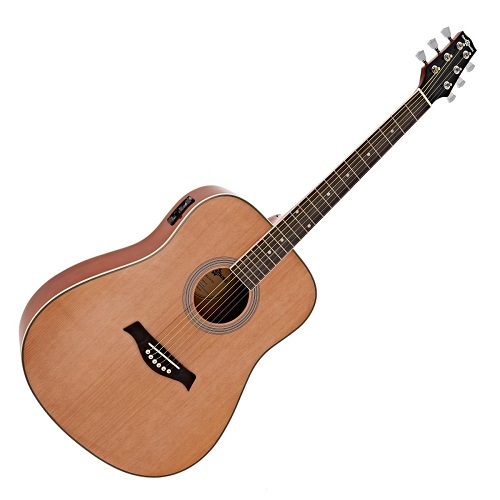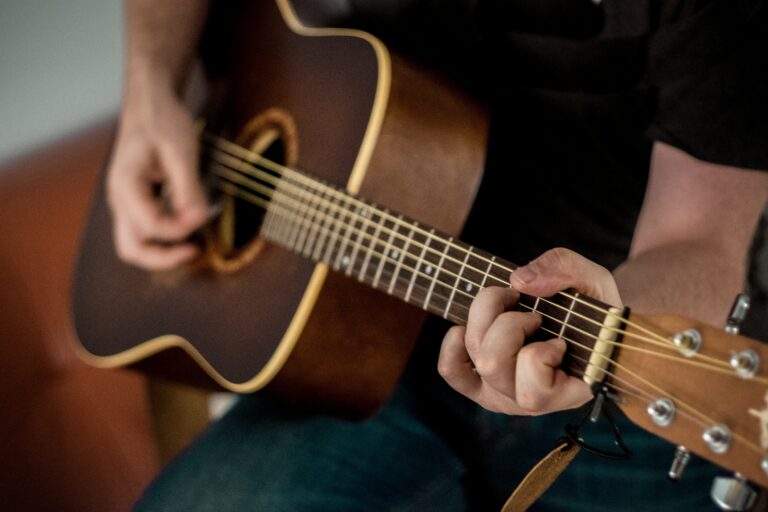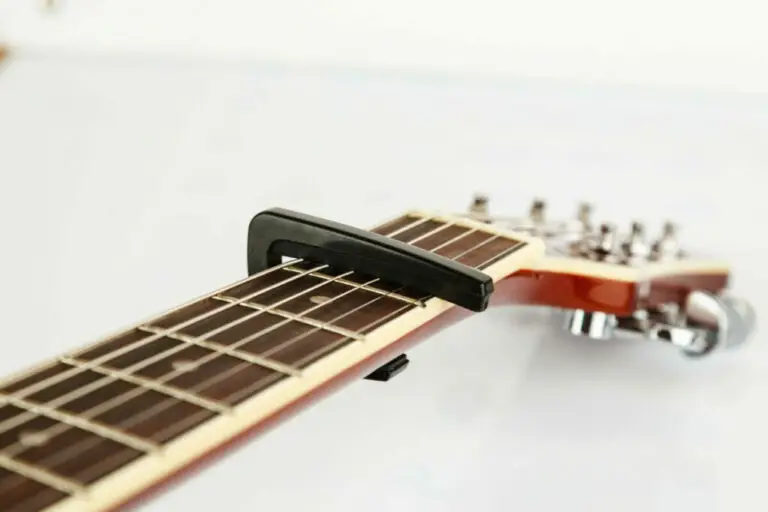Everything You Need To Know About Guitar Tonewoods
Discussing guitar tonewoods is like talking about a fine wine. Each type has been developed for centuries and brings a unique identity to whatever they are applied to.
Guitar tonewoods play a crucial part in forming an instrument’s identity as they dictate its overall sound, feel, and how they are played.
Whether you are using an acoustic or electric guitar, you will find that tone woods are the primary material found in the instrument’s construction.
The type of guitar tonewoods used will vary between the instrument’s body, neck, and fingerboard. It is why you will find dozens of wood combinations implemented between different models. With that in mind, what role do guitar tonewoods play in shaping the guitar as we know it today?
What are guitar tonewoods?
Tonewoods are precisely what the name suggests. They are types of wood that are known for naturally amplifying sounds yet are easy to shape and construct into a physical object. This doesn’t mean you can just cut down any random tree from a forest.
The ideal tone woods have several fundamental properties that are taken into consideration, such as:
- Density
- Hardness
- Elastic modality (stress vs. strain)
Only by taking in all these factors will you be able to consider the right tonewoods for particular areas. How do they influence a choice, though?
Density & Hardness
The most significant telling point in selecting wood is gauging its density and hardness. Making this choice is the biggest factor in creating the instrument’s sound. This affects how well the frequencies travel through the body once a string or item is picked.
Hardwoods are known for being excellent conductors of vibrations. It makes them particularly popular for neck and fingerboards and allows sound waves to travel toward the instrument’s body.
Softwood is nature’s best amplifier. Their ability to let vibrations travel within makes them perfect for releasing waves within a shape or structure. They are perfect for shaping guitar bodies to promote natural sounds.
Judging elastic modality
Aside from the material, tonewoods are also judged on how much they can take regarding stress and strain. This balance suggests elastic modality and determines what woods are suitable for use in each area of a guitar.
Hardwood will often have higher strain levels than softer materials. This means they are well suited for holding and transferring vibrational energy once a string is hit.
On the other hand, softwoods act oppositely. Their lighter nature helps release energy traveling down the body as a string is struck. This also allows the sound waves to bounce off the surface when released to project it into the surrounding areas.
Once you have worked out these components, you will know what does and doesn’t work as a good tonewood.
Exploring tonewood types
There are many kinds of wood to choose from when looking at guitar tonewood types. Indeed, you will find that many major manufacturers tend to use the same kind for related products. However, what are some of the most common types of tonewoods used today?
Maple
You won’t find many leading guitar types without some form of maple used within. Maple is an excellent tonewood because it can be used almost anywhere on a guitar. It is a naturally hard and dense wood perfect for use on neck and fingerboards. It can be carved and designed to work in a composite blend with softer woods when used on the body. The packed grains allow some naturally stunning finishes and design patterns to catch the eye.
Furthermore, it is a wood that is always readily available and easy to access. Grown within much of North America, any luthier or manufacturer can source maple to form the base of their instrument. This good availability is why you will see maple on any guitar ranging from a Jackson JS Dinky to a Baby Taylor acoustic.
Maple Properties
- Easily available
- Can be altered to form composite bodies
- Hard and dense – Good for use on the neck or body
Mahogany
You won’t go too far without discovering a guitar with mahogany interworked within the instrument. Being a relatively dense and heavy wood, mahogany is a wood that is commonly used within necks and top surfaces. However, this wood is often paired in composites with other materials to give a varied and complex sound. Naturally promoting mid-range sounds, mahogany is best known for being used by Gibson in their iconic Les Paul series.
Mahogany is another easy wood grown and cultivated worldwide for guitar makers. It can be grown anywhere from Africa to South America, meaning you won’t have to push too far to source the wood. Therefore, whether you have a solid mahogany axe or a composite blend, you can still enjoy a rich-sounding guitar that sounds and looks good.
Mahogany Properties
- Hard and solid for use on neck and tops
- Grown worldwide
- Can be formed to create top composite bodies
Rosewood
There are fewer premium tonewoods quite like rosewood. It is a very hard and dense wood, and rosewood is often used primarily within the fretboard due to its tough properties. This allows for it to maintain heavy use and is one of the more durable guitar tonewoods in the industry today. These features make it a highly sought-after material for manufacturers to use today.
However, some forms of rosewood are challenging to get hold of. Many classic signature guitars have used Brazilian Rosewood, but export limits have made it a rare commodity in many models. However, Indian rosewood variations are becoming a common substitute instead. You will find rosewood added as a composite blend, allowing it to be used sustainably and still adding a premium touch to many guitar models today.
Rosewood Properties
- Extremely durable
- Offers bright sounds
- Best used in fretboards
Basswood
Basswood is often considered a base material for any guitar body. Its presence as a lighter tone wood and softer nature makes it perfect for use as both side or back pieces. Being a softer tonewood, you will get many sounds suited for all rock types. You can play everything from harder to more soothing sounds when played correctly.
Basswood is a popular body material because it is extremely easy to get hold of. Grown and produced throughout North America, basswood bodies will be found in all guitars. Whether it is a high-end axe or just a basic beginner model, basswood is a material that has become a staple of modern guitar making today.
Basswood Properties
- Used primarily as a soundboard on guitar bodies
- Easily accessible
- Produces a breadth of different tones
Ash
For producing higher sounds, there are fewer tonewoods better suited than ash. When ash is used, you will find that it is used for the entire body and produces a twangy, light, breezy sound with a slight edge. Most guitar makers will use swamp ash as it makes a wide range of sounds.
Swamp ash can allow some great finishes to be added to the body. It can be left in its natural format or customized with designs. This versatility is why ash has been used since Fender launched their iconic Jaguar and Telecaster models in the late 1950s.
Ash Properties
- Light and twangy sound
- It can be used for the entire body
- Offers excellent natural or synthetic features
Cedar
Most models will have a cedar body top if you want an excellent acoustic guitar. Cedar allows a range of sounds to be generated with a superb projection for low and high notes. This allows for some great notes to be produced, whether you are hitting just one or multiple strings.
Cedar is also famous as a variety of excellent natural finishes are available depending on the type of cedar used. Some cedar forms, such as Alaskan cedar, have a light yellow or brown finish, while more exotic forms like Spanish cedar, will have a darker red or brown finish. With cedar types available across most of North America, it is also readily available for manufacturers to use sustainably and without any disruption.
Cedar Properties:
- Great range of sounds
- Excellent acoustic body top material
- A range of natural finishes is available
Spruce
For acoustic guitars, there are fewer more versatile tonewoods than spruce. No matter what type of spruce is used, you can be assured that the body will be resilient and capable of handling thousands of shows year after year. However, its overall strength doesn’t stop a range of excellent sounds from being produced, with spruce guitars offering warm sounds that accentuate low and high notes.
What makes spruce a particularly popular material is its many different forms that offer a great range of sounds. Sitka spruce is the most common type and suits all playing styles. You will find that Englemann and Lutz spruce tops offer similar sound properties with a lighter look than Sitka spruce.
Adirondack spruce produces more robust sounds and has a darker natural look; however, overuse in past years has seen it become a less frequent variant since the turn of the century. With spruce varieties growing worldwide, it’s abundant material worldwide, with new types being tested yearly.
Spruce Properties:
- Excellent natural finishes
- Very resilient for body top
- Multiple varieties can be used as tonewoods
Koa
For those looking for premium acoustic tonewood, koa usually is a great option to go for. Projecting excellent mid-range tones with a bright finish, it has a unique sound that very few tone woods can replicate. It makes it a popular body material for many premium acoustic models and has been used by the likes of Martin and Taylor throughout the years.
It also has a darker natural finish than many other acoustic tonewoods. This dark appearance makes it a popular finish for models many top rock and pop icons use. Found only in Hawaii, koa has become a rarer material due to its limited range. A rare but valuable tonewood in the modern landscape.
Koa Properties
- Used in acoustic bodies
- Excellent mid-range sounds
- Dark natural finish
The changing face of tonewoods
One battle that has emerged over the years regarding guitar tone woods is the availability and sourcing of some materials. This has come amid a greater concern about whether some materials could die out if not treated sustainably.
This comes as certain types of tone woods are only found in particular regions, limiting the amount that can be used over a certain period. This is true for any wood that is considered a premium material and one that is used in more high-end models.
If numbers of a particular type become rare, international bodies and governments will enforce restrictions on their use. These limits are usually enforced by international protocols such as CITES to give those plants a chance to recover naturally.
The battle for Brazilian rosewood
A great example of this has been the decline of Brazilian rosewood over the years. Rosewood itself has been a popular inclusion on fretboards throughout the 20th century.
Aside from its use for instruments, Brazilian rosewood has been used in other mainstream industries, such as furniture making and interior design. With this type only growing within certain parts of South-East Brazil, the supply quickly dwindled for commercial use.
Its overuse and from plants suffering from natural diseases, Brazilian Rosewood was marked as endangered in 1992 by CITES. This has stopped it from being mass cultivated for commercial use. The species has recovered to a point where they are now considered vulnerable in the CITES classification.
Guitar manufacturers have overcome this issue and use other variants, such as Indian rosewood. This has allowed Brazilian rosewood a chance to prosper and come back from the brink of extinction.
Knowing about guitar tonewoods
As you can see, guitar tonewoods play a big role in giving a guitar a unique identity. They also affect the look and sound too. Manufacturers and luthiers always look carefully at a wood’s properties (such as density and strength) to see how to use it when crafting. Doing this helps them better understand what the result might sound like.
You will find that common woods like maple and mahogany are great for use anywhere on a guitar. Other woods, such as rosewood and ash, have more unique properties creating particular sounds and looks. For acoustic models, softer woods such as cedar and spruce give excellent natural finishes with great all-around sounds. However, there is a need to be aware of how wood is used to prevent them from being overused and putting the plant at risk of extinction.
By doing all this, you can be assured that tonewoods can continue to be used to create excellent guitars for musicians to use anywhere on the planet. And it’s by using guitar tonewoods that new music can shine for years.









